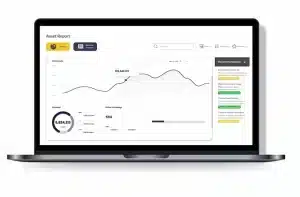In the fast-paced world of modern business, equipment and machinery play a vital role in supporting smooth operations. With the increasing reliance on technology, ensuring equipment is working optimally has become a key requirement. Sudden equipment breakdowns can cause production disruptions and incur high costs. This is where equipment maintenance plays an important role
Equipment maintenance is a routine maintenance process that aims to keep equipment functioning according to specifications. This process includes inspection, repair, and replacement of parts if needed. With proper maintenance, the risk of sudden breakdowns can be minimized, keeping operations running smoothly.
So, how do you implement equipment maintenance to ensure that your equipment stays well-maintained? Continue reading this article until the end because we will discuss equipment maintenance in depth, starting from the definition, benefits, types, and importance of tools and equipment maintenance.
Table of Contents

Key Takeaways
|
What is Equipment Maintenance?
Equipment maintenance is a maintenance process that involves routine maintenance, repair, and periodic inspection of equipment and machinery to ensure their optimal performance. It aims to prevent sudden breakdowns of operational equipment that can disrupt business operations.
The maintenance process involves various activities such as cleaning, regular checks, and replacing worn or damaged parts. By performing regular maintenance, companies can ensure that every component of their equipment is always in the best condition.
The benefits of maintenance are enormous for companies, including increasing productivity and operational efficiency. By keeping equipment in optimal condition, downtime or production stoppages caused by breakdowns can be minimized. In addition, proper maintenance can extend the life of equipment and reduce costs incurred for major repairs or replacement of damaged equipment.
Equipment Maintenance Example
We have already discussed the definition of maintenance. However, you must be curious about an example of the application of this process. Therefore, we will provide examples of the application of equipment maintenance from various industrial sectors so that you can easily understand it.
Here is an example that you can refer to:
Manufacturing industry
In production factories, maintenance is applied to ensure that production machines such as conveyors, printing presses, and other heavy equipment function optimally. Regular maintenance prevents breakdowns that can disrupt production lines and increase production efficiency.
Transportation industry
In transportation companies, such as airlines and logistics companies, maintenance is performed on vehicles, planes, or ships. Regular checks such as engine, tire, and brake checks ensure vehicles operate safely and reduce the risk of accidents.
Agriculture industry
Tractors, harvesters, and irrigation systems require maintenance to function efficiently during planting and harvesting seasons. Tools and equipment maintenance helps farmers optimize productivity and prevent losses due to equipment breakdowns in the middle of the season.
Construction industry
Heavy equipment such as excavators, cranes, and bulldozers require regular maintenance to prevent mechanical failure during projects. Tools and equipment maintenance in this sector is very important to maintain work safety and extend the life of heavy equipment.
Energy industry
In power plants, maintenance of turbine engines, generators, and transmission systems is carried out to prevent damage that could lead to power outages. Maintenance schedule in this sector is crucial to maintain a stable energy supply.
Types of Equipment Maintenance
Through our previous explanation, you can understand what are some examples of the application of maintenance. Next, we will take you one step further in understanding maintenance by explaining the types of equipment maintenance.
Yes, equipment maintenance itself is divided into several types, each of which has a different purpose. Here is an explanation of each type of maintenance:
Preventive maintenance
Preventive maintenance is tools and maintenance that is carried out on a scheduled and regular basis to prevent damage to equipment. It includes actions such as visual inspection, lubrication, cleaning, calibration, replacement of parts that are prone to wear, as well as checking critical functions on the equipment.
It aims to minimize the risk of breakdowns and extend the life of equipment by taking care of potentially faulty components before problems arise. With regular maintenance, companies can reduce downtime due to breakdowns, improve operational efficiency, and minimize sudden repair costs.
Corrective maintenance
Unlike the previous type of maintenance, corrective maintenance is performed after the equipment has been damaged or malfunctioned. It is a corrective measure to restore the equipment to its normal operating condition, so it is usually unscheduled as it is only performed after the problem arises.
Although more reactive, these repairs are important in dealing with sudden breakdowns. However, corrective maintenance is often more expensive as unplanned downtime can disrupt production and take longer to complete.
Therefore, many companies are trying to reduce reliance on corrective maintenance by adopting a preventive or predictive maintenance approach.
Condition-based maintenance (CBM)
Condition-based maintenance is performed based on the actual condition of the equipment, rather than on a specific time schedule. CBM involves continuous monitoring and inspection of equipment to detect changes in component performance or condition.
For example, operators will notice signs such as abnormal vibrations, noises, or temperature changes, which signal the need for maintenance action. With this approach, companies only carry out repairs when there are indications of problems, making maintenance more effective and focused on real needs. CBM helps companies avoid excessive maintenance and extend equipment life.
Predictive maintenance
Predictive maintenance uses technology and real-time data to monitor the condition of equipment and predict when it may fail. Technologies such as sensors, vibration analysis, temperature monitoring, or oil analysis are used to detect early signs of wear or failure. The data collected is then analyzed to predict when repair or replacement of components is required.
As such, predictive maintenance allows companies to perform maintenance only when it is necessary based on the actual condition of the equipment, reducing unnecessary repair costs and time, avoiding over-maintenance and extending equipment life.
In accordance with the way monitoring is done, carrying out this type of maintenance can run well with the help of a system, such as one of HashMicro’s asset systems. Apart from being able to help monitor the condition of the equipment, this system can also estimate the cost of the maintenance budget to assist the finance department in preparing special maintenance funds.
If you are interested, you can try the free demo by clicking here!
Emergency maintenance
Emergency maintenance occurs when equipment experiences a sudden failure and requires immediate repair to avoid greater operational disruption. This type of maintenance is unplanned and often requires additional resources or labor immediately to deal with the breakdown.
One example of this is if a major production machine breaks down while operations are ongoing, emergency maintenance is performed to fix it as quickly as possible to reduce downtime. While it is important for emergency situations, emergency maintenance is usually more expensive and inefficient compared to planned maintenance due to the time it takes and the higher risk of losses due to undetected breakdowns.
Benefits of Equipment Maintenance Implementation for Company Productivity
Here are five benefits of implementing equipment maintenance for companies:
Increase equipment lifespan
By performing regular maintenance, companies can extend the life of their equipment. Regular maintenance helps maintain the condition of components, prevents excessive wear and tear, and ensures the equipment remains in good working order for longer. This reduces the need to replace expensive equipment in the short term.
Reduced downtime and operational disruptions
Proper maintenance allows companies to prevent sudden breakdowns that can cause downtime. With a regular maintenance schedule, companies can keep equipment in optimal condition and avoid unexpected operational disruptions. Lower downtime means higher productivity and increased work efficiency.
Save on repair costs
Preventive and predictive maintenance helps reduce the cost of major repairs due to serious breakdowns. The cost of routine maintenance is usually much lower than the cost of emergency repairs or replacement of completely damaged parts.
Now, imagine if you didn’t do preventive or predictive maintenance. The number of breakdowns and replaced parts would probably be much higher. On the other hand, because you implement preventive maintenance, you can prevent more severe damage because maintenance is done after the machine has broken down.
In addition, minimizing downtime also reduces financial losses due to interrupted production.
Improving operational efficiency
With equipment that is always in optimal condition, companies can run operations more efficiently. Well-maintained equipment tends to work at maximum capacity, without any bottlenecks or performance degradation. This allows for a smoother workflow and optimizes the use of resources.
Maintain safety and security
Maintenance is also very important to maintain safety in the workplace. Poorly maintained equipment can pose a risk of workplace accidents, such as dangerous machine failures. By performing regular maintenance, companies can ensure that all equipment operates safely, protect employees from potential hazards, and comply with industry safety standards.
Tips for Tracking Equipment Maintenance to Be Effective for Companies
So far, your understanding of equipment maintenance has increased. However, you may still find it difficult when implementing maintenance. Not to worry, we will give you some tips on how to monitor preventive maintenance of tools and equipment to keep it right for your productivity.
Here are some tips that you can refer to:
Use of computerized maintenance management system (CMMS)
CMMS is software used to manage and track maintenance activities. With this system, companies can schedule routine maintenance, record maintenance history, and manage spare parts inventory. CMMS also provides automatic notifications when maintenance is required, helping to avoid maintenance omissions.
The system provides clear visibility into the condition of the equipment and the maintenance activities that have been performed. Although you may not be familiar with the use of asset management system, you don’t need to worry because in today’s modern business era it is very easy to find, such as HashMicro and many more.
You can also read our previous article that discusses asset management system recommendations.
Real-time monitoring with IoT (Internet of Things)
IoT technology allows companies to monitor equipment conditions in real-time through sensors installed on machines. These sensors can measure various parameters such as temperature, vibration, or pressure, which indicate the health of the equipment.
The data from these sensors is sent to a central monitoring system, which allows companies to detect potential problems before they occur. With real-time monitoring, companies can take immediate action if there are anomalies in equipment performance.
Manual reports and periodic inspections
Another way to track maintenance activities is through regular inspections conducted by technicians or operators. They can create manual reports regarding the condition of the equipment after inspection or repair.
These reports are then recorded in the maintenance log to ensure every activity is well-documented. Although more traditional, this method is still effective in monitoring equipment, especially when coupled with a digital system to track maintenance history and repair schedules.
Avoid Productivity Disruption by Implementing Proper Equipment Maintenance with HashMicro!

HashMicro Asset Management System is a software designed to assist companies in managing maintenance inspection checklists. The system allows users to track the entire lifecycle of an asset, from procurement to maintenance to disposal, thereby maximizing asset value and optimizing business operations.
One of the main advantages of this system is its comprehensive features that include inventory management, asset location tracking, maintenance schedules, as well as real-time asset performance reports. In addition, HashMicro does not limit the number of users at no extra cost to make it easier for companies with large teams involved in asset management.
Furthermore, HashMicro’s asset management system is also easily integrated with other systems such as ERP, accounting, or inventory management, enabling seamless data flow and improving operational efficiency across multiple departments.
Here are the comprehensive features of HashMicro that can make it easier for you to perform equipment maintenance:
- Asset Maintenance Budget: A feature to manage and track the maintenance budget for each asset or group of assets.
- Preventive Maintenance Scheduling: Easily create asset maintenance schedules to prevent unexpected operational disruptions, ensuring that all assets remain in good working order.
- Asset StockTake with Barcode: Report asset status (breakdown, operative, missing, found, etc.) into the system using barcodes.
- QR Code Scanning for Facilities Request: QR code scanning feature installed in various facilities or equipment to submit repair or maintenance requests quickly and efficiently.
Conclusion
Performing equipment maintenance is an important procedure that needs to be carried out by the company to be able to ensure that production equipment can continue to run optimally and support the needs required by the company. The implementation of maintenance is also important to avoid more severe damage and result in large losses.
Furthermore, one way to implement proper maintenance is by implementing an asset management system, such as that of HashMicro. This system offers a complete range of features to support proper maintenance and minimize errors.
Immediately realize efficient equipment maintenance using the HashMicro system by scheduling a free demo now!




































